Tinplate Toys
Tinplate Toys .. A History of Tin Toys
.
The one area of yesterdays toys that I never get tired of delving into is that of tinplate toys. There again it is such a vast area for the collector, both serious and not quite so, to choose from …. cars, trucks, planes, boats, clockwork, friction-drive, buildings, animals, by decade etc, etc ….
Because it is such a large topic to cover in one go it is an area which I will be returning to time and time again under various headings. For the purpose of this particular post I will attempt to give a simplified overview of the subject and save a more in depth look at the various catagories for another day.
.
A BRIEF HISTORY of TIN TOYS
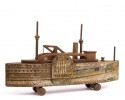
Tinplate (thin sheets of steel plated with tin) was used in the manufacture of toys from the mid to late 1800’s. Previous to this the majority of toys were made from wood, some were simplistic often crude in their manufacture, some, like this 19th century example of a steam paddle boat from the USA were a delight with its printed paper overlay and deck fittings, but not intended to be the plaything of your average child in the late 1800’s.
Prior to WW1 the early tin toys were often painstakingly hand painted – the advent of chromolithography was to change all that. Although this technology had been around since the late 1800’s it wasn’t until the early 1900’s that it was commonly applied to tin toys. The technique allowed multi-coloured illustrations to be printed on to flat sheets of tinplate which could then be stamped out and put together by means of bendable tabs to form the finished toy.
By the early part of the 20th century Germany was the leading producer of tin toys in the world a position which it maintained right up to the outbreak of WW11. The bulk of its production was designed and destined for export to meet an ever increasing demand for reliablity and quality at realistic prices, 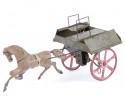 clockwork motors were incorporated into the models to add movement and even greater sense of realism to the toy.
clockwork motors were incorporated into the models to add movement and even greater sense of realism to the toy.
Most of these early German companies the likes of BING (1863), FLEISCHMAN (1887), LEHMANN (1881), GUNTHERMANN (1880) and MARKLIN (1859) were to produce an array of classic toys, highly sought after by todays collectors, but which were certainly equalled and even surpassed by the later German manufacturers such as ARNOLD (1906), TIPP (1912) and SCHUCO (1912) to name but three.
With mass production came mass appeal and it wasn’t long before the German dominance of the market came under threat by the appearance of other manufacturers in both Europe and the USA. CHAD VALLEY and LINES BROS. were two of the early British companies to make their mark as the British public shunned German goods, including toys, following the First World War. The Americans had always had a history of tin toy manufacturing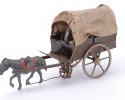 dating back to the mid 1800’s with the likes of the PHILADELPHIA TIN TOY MANF., FALLOWS, BERGMANN, IVES and BUCKMAN this reputable list was added to by the likes of UNIQUE ART, STRAUSS, CHEIN, WOLVERINE and MARX.
dating back to the mid 1800’s with the likes of the PHILADELPHIA TIN TOY MANF., FALLOWS, BERGMANN, IVES and BUCKMAN this reputable list was added to by the likes of UNIQUE ART, STRAUSS, CHEIN, WOLVERINE and MARX.
The outbreak of WW11 saw great changes to all aspects of life from which the toy market was not immune. Production was given over to munitions as men, women, machines and materials did their bit for the war effort. So much so that when peace eventually returned toy makers everywhere had a great deal of lost ground to make up. However German dominance was at an end and companies in the UK like METTOY and BRIMTOY were producing a large range of high quality tinplate toys.
But this new dawn also saw the emergence of a new market leader in the 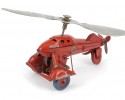 shape of Japan. Japan had been a major producer of tin toys for as long as the Europeans but it was not until the late 1940’s and ’50’s and even into the early 1960’s that production reached its height with the introduction of many new novelties. Not just wind-up and friction drive motors but Japanese tin plate toys were also incorporating battery power not simply to drive the toy but also to provide lights and sounds.
shape of Japan. Japan had been a major producer of tin toys for as long as the Europeans but it was not until the late 1940’s and ’50’s and even into the early 1960’s that production reached its height with the introduction of many new novelties. Not just wind-up and friction drive motors but Japanese tin plate toys were also incorporating battery power not simply to drive the toy but also to provide lights and sounds.
The Japanese through an extensive number of reputable tin toy companies, MARUSAN, MASUDAYA, NOMURA, YONEZAWA and BANDAI … the list goes on … now began to flood the market with many appealingly designed tinplate toys aimed specifically at the massive U.S. market.
But the market never stands still and despite this relative boom in the post war era, tin toy manufacturing was facing its biggest threat yet …….. the plastic revolution.
For more information on tinplate toys please see my further listings under specific manufacturers.

Hi Roger
I have recently got some tin toys but can find absolutely nothing to identify them or the make
I’d love to try and acquire more as it would be a set but without any indicators I’ve no idea how to look.
I don’t see anyway to upload a picture sorry
But there is a chute, a seesaw, a deckchairs and normal chair. The main parts are a blue colour. No decor or decal etc . I’d say 1:16 scale like triang dolls houses
Anywhere or any advice on how to trace them
Thanks
Mariea
Hi there Mariea and thanks for forwarding me your pics on the miniature furniture.
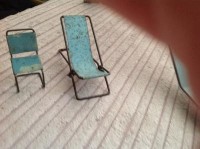 I have included one so everyone else will know what we are talking about.
I have included one so everyone else will know what we are talking about.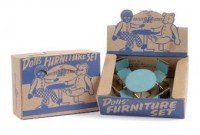
The furniture is tinplate to the main body of each piece built around a thick tubular metal frame. Its obvious from the construction that the tubular frame has been shaped around a former as the bends are consistant but don’t know how the body and frame are held together from your pics. (You will be able to tell if its the usual tab construction or simply soldered).
Took a bit of digging but I found these items were made under the brand ‘BUTLER SERIES’ of dolls house furniture.
Dating to the 1950’s / 60’s these pieces of furniture were made in England and sold in boxes simply illustrated with a golly and teddy. The box could be opened out to make a nice counter display for sales purposes. Your items are finished in blue but were also available in red paint finish. Would realise around £20, boxed and in good condition.
To paint or not to paint ? Always a tricky decision, not a high residual value so its down to personal preference
but as you have some tarnishing showing through its not much use just painting over as it will only come through again eventually. Will take a little work to strip and repaint as well as cleaning up the brightwork. So long as youngsters aren’t playing with these pieces and if its only for display I would be tempted to leave them as they are.
Hope this helps you, David.